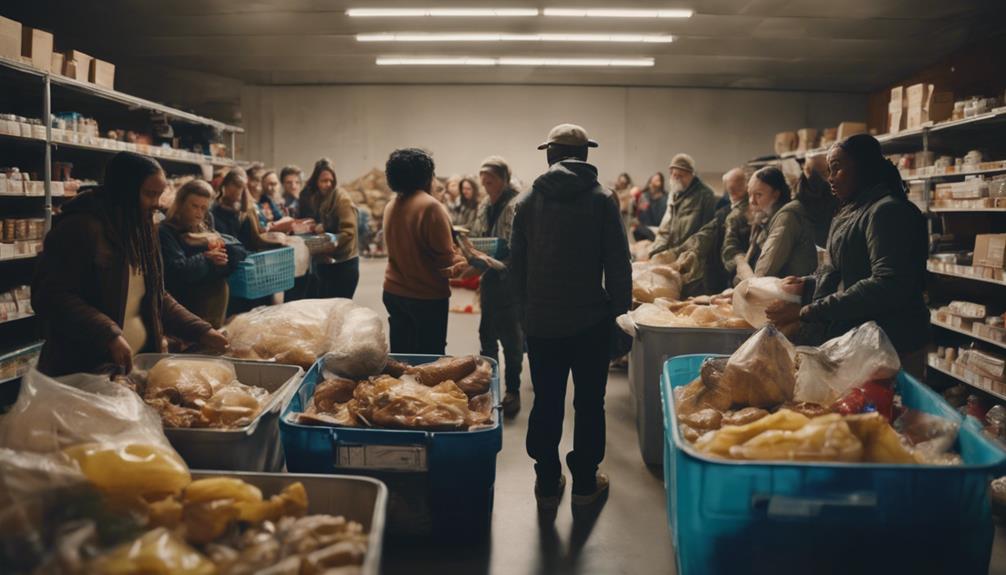FEMA PODs, or Points of Distribution, are critical lifelines during disasters, providing you with essential supplies like food, water, and medical items. They operate daily from 7 am to 7 pm, often located in accessible areas like schools for convenience and safety. Managed by trained personnel, these PODs guarantee a fair distribution on a first-come, first-served basis, so it's smart to arrive early. With community involvement and local agencies collaborating, PODs effectively address urgent needs. If you want to find out more about their innovative strategies and community impacts, there's plenty more to uncover.
Key Takeaways
- FEMA PODs provide essential supplies like food, water, and medical items to communities affected by disasters.
- Operated by FEMA and local agencies, PODs ensure rapid response and accessibility during emergencies.
- Strategically located in public spaces, PODs accommodate large crowds and prioritize safety for all visitors.
- Efficient distribution is managed by trained personnel, emphasizing fair access through a first-come, first-served model.
- Community involvement and volunteer support enhance the effectiveness and resilience of FEMA POD operations during crises.
Understanding FEMA PODs

Often, when disasters strike, communities can feel overwhelmed by the immediate need for resources. That's where FEMA PODs, or Points of Distribution, come in.
These temporary setups provide essential supplies like food, water, and medical items to those affected. When regular distribution channels break down, PODs activate to guarantee you get the help you need quickly.
Operated by FEMA alongside local agencies, they play a significant role in rapid response efforts. You'll find PODs strategically located to maximize accessibility and safety, often in familiar places like schools.
Key Resources Provided

During a disaster, having access to essential resources can make all the difference in recovery. FEMA PODs provide critical supplies that you and your community may need to get back on your feet.
At these distribution points, you can find food, clean water, blankets, and medical supplies. In some cases, the Strategic National Stockpile may even offer vaccines and antibiotics.
The supplies are distributed on a first-come, first-served basis, so getting there early can guarantee you receive the essentials. It's also recommended to arrive by vehicle to speed up the process.
With trained personnel managing operations, FEMA PODs are designed to meet your immediate needs during times of crisis, helping you navigate the recovery journey more effectively.
Operational Hours and Management

FEMA PODs operate daily from 7 am to 7 pm, ensuring you have access to essential supplies when you need them most.
Local agencies manage the operations, coordinating the distribution process efficiently. Trained personnel are essential for effective management, handling the flow of supplies and assisting you during your visit.
To minimize delays, it's recommended to arrive early, as supplies are distributed on a first-come, first-served basis. Vehicle access can streamline your experience, allowing for quicker pick-up of necessary items.
Understanding the operational hours helps you plan your visit, ensuring you receive the support you need. By following these guidelines, you can navigate the POD process smoothly and access crucial resources during challenging times.
Selecting POD Locations

After understanding the operational hours and management of PODs, it's important to contemplate how locations are selected for these distribution points.
You'll find that safety and accessibility are the primary considerations. Local officials often choose locations like public schools, as they're spacious and can accommodate large crowds without overwhelming hospitals.
Collaborating with community partners helps pinpoint ideal sites, ensuring they meet the needs of residents. These choices are documented in Emergency Response Plans, allowing for quick action during crises.
Ultimately, the goal is to support as many people as possible, with some PODs capable of serving up to 20,000 individuals daily.
Your involvement in identifying and promoting these locations can greatly enhance the overall effectiveness of disaster response efforts.
Overcoming Distribution Challenges

When facing the challenges of distributing supplies through PODs, effective strategies are essential for success. You need to prioritize communication, ensuring all agencies are aware of their roles during distribution. Streamlining logistics can help address transportation issues, especially in remote areas.
| Challenge | Strategy | Outcome |
|---|---|---|
| Limited resources | Partner with local organizations | Increased supply availability |
| Public awareness | Educate communities | Higher attendance at PODs |
| Safety concerns | Implement crowd control measures | Safer distribution events |
| Complex logistics | Use technology for tracking | Improved efficiency |
Innovations for Future Operations

To tackle the ongoing challenges faced by Point of Distribution (POD) operations, innovations in technology and community engagement are on the horizon.
You're likely to see enhanced distribution systems powered by real-time data analytics, allowing for better resource allocation and tracking. Mobile apps could provide essential updates, ensuring affected individuals know where to find vital supplies quickly.
Additionally, using drones for delivering resources to hard-to-reach areas may become a reality, streamlining logistics.
Training programs for local volunteers will also evolve, equipping them with skills to support POD operations efficiently.
These innovations not only aim to boost efficiency but also strengthen community resilience, ensuring you and your neighbors receive timely assistance during disasters. Furthermore, these advancements in technology are also designed to provide access to vital resources such as food, water, and medical supplies in the event of a crisis. In fact, some of these new tools are being referred to as ‘top survival tinders‘ due to their ability to ignite community support and aid in times of need. This shift towards more resilient and connected communities is crucial in preparing for and responding to emergencies.
Community Involvement and Support

Community involvement is essential for the success of FEMA PODs, as local support can amplify resource distribution and guarantee that those in need receive assistance swiftly.
When you engage with your community, you help identify specific needs and mobilize resources effectively. Volunteers play an important role in staffing PODs, managing supply distribution, and providing information to those seeking help.
Your participation fosters a sense of unity and shared purpose, ensuring that everyone has access to necessary supplies. Additionally, by spreading awareness about PODs and their locations, you can minimize confusion during emergencies.
Together, your community can create a resilient support network that enhances the overall effectiveness of FEMA's disaster response efforts, making a significant difference in the lives of those affected.
Frequently Asked Questions
How Can I Find the Nearest FEMA POD During a Disaster?
To find the nearest FEMA POD during a disaster, check local news updates, visit emergency management websites, or call community helplines. They'll provide real-time information on locations and availability of essential supplies.
Are There Eligibility Requirements to Receive Supplies From FEMA Pods?
Did you know that FEMA PODs can serve up to 20,000 people daily? You don't need specific eligibility requirements to receive supplies; just show up, and they'll provide essential items to those in need.
Can I Volunteer at a FEMA POD During a Disaster?
Yes, you can volunteer at a FEMA POD during a disaster. They often seek dedicated individuals to help with distribution and logistics. Check local emergency management websites for opportunities and training sessions to get involved.
What Types of Identification Are Needed at FEMA Pods?
At FEMA PODs, you typically need government-issued ID to verify your identity. If you're picking up supplies for someone else, bring their ID too. Always check local guidelines for any specific requirements before heading out.
How Is the Distribution Process Managed at FEMA Pods?
The distribution process at FEMA PODs is managed by local agencies that organize and oversee supply distribution. Trained personnel guarantee efficiency, with items given on a first-come, first-served basis to those in need.
Conclusion
In the face of adversity, FEMA PODs serve as your guiding light, ensuring you're not left in the dark. By providing essential supplies and support, these lifelines empower you to navigate the storm with confidence. As communities rally together, these temporary hubs adapt and evolve, ready to tackle whatever challenges lie ahead. So, when the clouds gather, remember that help is just around the corner, waiting to lend a hand and brighten your path to recovery.










